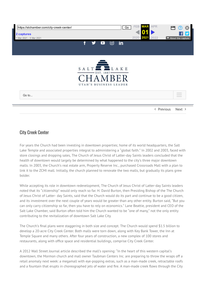Marisa Bomis writes H. David Burton told Lane Beattie that the Church wanted to be “one of many,” not the only entity revitalizing downtown Salt Lake City. Church originally planned to renovate two existing malls.
- Type
- Website
- Source
- Marisa Bomis
- Hearsay
- 3rd Hand
- Reference
Marisa Bomis, “City Creek Center,” Salt Lake Chamber of Commerce website (April 5, 2017), accessed July 1, 2021
- Scribe/Publisher
- Salt Lake Chamber
- People
- Salt Lake Chamber, Marisa Bomis, H. David Burton, Lane Beattie
- Audience
- Reading Public
- Transcription
City Creek Center
For years the Church had been investing in downtown properties; home of its world headquarters, the Salt Lake Temple and associated properties integral to administering a “global faith.” In 2002 and 2003, faced with store closings and dropping sales, The Church of Jesus Christ of Latter-day Saints leaders concluded that the health of downtown would largely be determined by what happened to the city’s three major downtown malls. In 2003, the Church’s real estate arm, Property Reserve Inc., purchased Crossroads Mall with a plan to link it to the ZCMI mall. Initially, the church planned to renovate the two malls, but gradually its plans grew bolder.
While accepting its role in downtown redevelopment, The Church of Jesus Christ of Latter-day Saints leaders noted that its “citizenship” would only reach so far. H. David Burton, then Presiding Bishop of the The Church of Jesus Christ of Latter- day Saints, said that the Church would do its part and continue to be a good citizen, and its investment over the next couple of years would be greater than any other entity. Burton said, “But you can only carry citizenship so far, then you have to rely on economics.” Lane Beattie, president and CEO of the Salt Lake Chamber, said Burton often told him the Church wanted to be “one of many,” not the only entity contributing to the revitalization of downtown Salt Lake City.
The Church’s final plans were staggering in both size and concept. The Church would spend $1.5 billion to develop a 20-acre City Creek Center. Both malls were torn down, along with Key Bank Tower, the Inn at Temple Square and many others. After four years of construction, a new complex of 100 stores and restaurants, along with office space and residential buildings, comprise City Creek Center.
A 2012 Wall Street Journal article described the mall’s opening: “In the heart of this western capital’s downtown, the Mormon church and mall owner Taubman Centers Inc. are preparing to throw the wraps off a retail anomaly next week: a megamall with eye-popping extras, such as a man-made creek, retractable roofs and a fountain that erupts in choreographed jets of water and fire. A man-made creek flows through the City Creek Center. Costly amenities aside, City Creek Center stands out simply because malls this size aren’t often built in the U.S. anymore. But, the 700,000-square-foot mall has something other projects don’t: financial backing from the development arm of The Church of Jesus Christ of Latter-day Saints. That has enabled the Church and Taubman to include numerous high-price extras and to lure high-profile retailers.”
By MBomis | April 5th, 2017|Chamber History, Downtown Rising | 0 Comments
- Citations in Mormonr Qnas
The B. H. Roberts Foundation is not owned by, operated by, or affiliated with the Church of Jesus Christ of Latter-day Saints.

